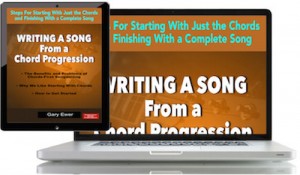When you start your songs the same way, you make it very likely that there will be an unpleasant sameness about them. Your aim as a songwriter should be to feel at ease with as many different processes as possible for starting songs.
Comfort with many different processes makes it more likely that your songs will sound refreshingly different. Just as taking a walk by starting in a new direction will mean that your entire walk will follow a different path, starting songs differently means that the end product will sound at least partly unique to the audience, and that’s usually a good thing.
 Do you find that writing a great melody is your biggest challenge? In great songs, it’s not just about the tune — Melodies are great when they partner well with lyrics and chords. Learn more about that important partnership in “The Essential Secrets of Songwriting.” $27, but get it at a huge discount when you buy the 10-eBook Bundle.
Do you find that writing a great melody is your biggest challenge? In great songs, it’s not just about the tune — Melodies are great when they partner well with lyrics and chords. Learn more about that important partnership in “The Essential Secrets of Songwriting.” $27, but get it at a huge discount when you buy the 10-eBook Bundle.
But what are the different ways you can start a song? Often, it simply requires that very first step to be unique, and then you’ve got the makings of a new pathway that sets itself apart from other possible ones.
Here’s a list of ideas to try; you should attempt as many as possible. When it comes to songwriting processes, the more the merrier.
- Rhythm first: set up a drum loop as a foundation for chord/hook improvisation. This is a great way to begin a group improvisation, and it was a favourite process for later Genesis, according to bassist/guitarist Mike Rutherford.
- Melodic idea first. Play a few chords on guitar or keyboard to get your thinking locked into a key. Then, without playing chords, invent a 4- to 6-note or longer melodic idea. Now start to apply chords to this idea. You’ll find that many ideas will work with very different progressions, and each change of progression changes the mood of the melodic idea. Listen to this fragment, and how its mood changes with each change of progression.
- Lyrics first. By developing a lyric first — or at least a good portion of the lyric — you’ll find that the words suggest certain rhythms and certain melodic shapes. So after you’ve worked out a fair bit of the lyric, read it aloud, over and over again, experimenting with different ways to say the words. Once melodic ideas and rhythms coalesce, you’ll find the rest of the song starts to come together fairly easily.
- Chords first. Loop a chord progression and experiment with melodic fragments that fit the chords. You can use this process to simply get the song started, but keep in mind that for each section of your song that uses a unique progression (verse, chorus, bridge, etc.), you can use this method as a starting point.
That’s just four possible processes, but you’ll find that you can develop other ones by combining ideas. For example, the rhythm-first process can be enhanced by chanting words that work with the rhythmic pattern you develop.
The point is that the more processes you can feel at ease with, the greater the chance you’ll have of creating a song that’s truly unique and fresh. And since improvisation is a powerful tool for popular songwriting, they’ll all work well as part of a group songwriting collaboration.
 Written by Gary Ewer. Follow Gary on Twitter.
Written by Gary Ewer. Follow Gary on Twitter.
 If you like starting songs by working out a good chord progression, you need to get “Writing a Song From a Chord Progression.” It shows you the strengths and pitfalls of this very common songwriting process.
If you like starting songs by working out a good chord progression, you need to get “Writing a Song From a Chord Progression.” It shows you the strengths and pitfalls of this very common songwriting process.










